|
THE FRENCH EMPIRE IN
AFRICA |
|
French colonization in Africa began in the seventeenth century with
the establishment of trading posts on the coast of what is now
Senegal. From this and other coastal enclaves French influence
expanded into the interior, particularly during the second half of
the nineteenth century. By the end of World War I the French empire in continental Africa (excluding Algeria, Tunisia
and the Moroccan protectorate in the north and French Somaliland in
the east) comprised twelve colonies and two League
of Nations mandate territories (former German colonies). These were grouped into two
federations, French West Africa (eight colonies and one mandate
territory) and French Equatorial Africa (four colonies and one
mandate territory). The League mandates were technically not French
colonies or members of the federations but in practice they were
treated as such. Each federation had a governor-general and each
colony had a governor, these authorities being appointed by the
French government. The national flag of all French colonies was the
Tricolor and in contrast to the British Empire there were no
distinctive flags or ensigns for individual colonies. During the
pre-independence period (1955-60), however, some colonies were
granted their own flags, several of which are depicted below. A
governor-general was entitled to a square blue flag with a canton of
the Tricolor and governors of colonies had a swallowtailed variant
of the same. These flags were mostly used at sea.
After World War II the French Empire was renamed, first being titled
the French Union and then the French Community. The flag of the
latter was a Tricolor, fringed yellow, charged with the motto of
the French Republic. Inhabitants of the colonies, who for the most part
had been treated as subjects, gained political rights for the first
time under the new arrangements, including qualified French
citizenship. But in the late 1950s France decided to divest itself
of its African colonies and they were all granted independence by
1960. The French Community was continued as an organization
analogous to the British Commonwealth of Nations but the idea never
really took root and it was abolished in 1995. |
|
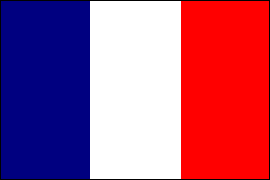
The
Tricolor |
|
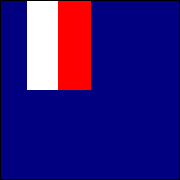
Colonial
Governor-General |
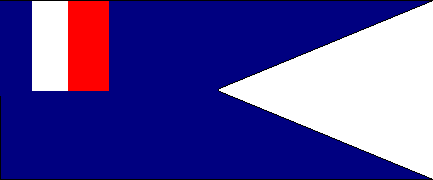
Governor of a
Colony |
|
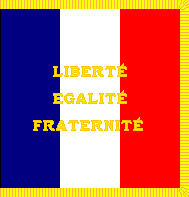
French Community
• 1958-95 |
|
FRENCH WEST AFRICA
•
Afrique Occidentale Française |
|
The colonies of French West Africa received their independence in
1959-60. Senegal and Mali were originally united as the Mali
Federation but this proved unworkable and Senegal succeeded in 1960.
The flag of the Mali Federation was a tricolor of the Pan-African
colors with a stylized image of a human being, called the kanaga,
on the yellow stripe. When the federation broke down Senegal
replaced the kanaga with a green star to create its national
flag. Mali continued to use the federal flag for about a year. But
Muslim religious objections to the depiction of the human form then
led to the removal of the kanaga and since 1961 the flag of
Mali has been a plain green-yellow-red-tricolor. Most of the other
colonies of French West Africa adopted national flags based on the
Pan-African colors but there were exceptions, e.g. Upper Volta, whose
flag was a horizontal black-white-red tricolor identical to the flag
of the former German Empire. Upper Volta renamed itself Burkina Faso
in 1984, adopting a new flag in the Pan-African colors. Niger and
the
Côte d'Ivoire chose orange, white and green as their national
colors. Orange symbolizes the sun, green the land and white is for
peace. Mauritania, styling itself an Islamic republic, adopted a
green flag with yellow star and crescent, traditional colors and
symbols of Islam. Dahomey renamed itself Benin in 1975, declared itself a
people's republic and adopted a new flag: green with the red star of
communism in the upper hoist. This flag was abolished along with the
people's republic in 1990, communism having fallen out of fashion,
and the 1959-75 flag was readopted. Senegal and Togo (which was a
mandate territory) were granted distinctive flags in the
pre-independence period.
The Pan-African colors were taken from the flag of Ethiopia, the
only country on the African continent that had successfully resisted
European colonization. They were first used by the former British
colony of the Gold Coast, which when it achieved independence in
1957 as the Republic of Ghana adopted a horizontal tricolor of red,
yellow and green stripes with a black star on the yellow stripe. |
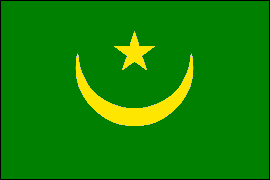
Islamic Republic of Mauritania |
|
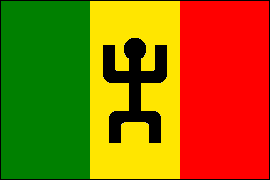
Federation of Senegal
and Mali • National Flag 1960
Republic of Mali
• National Flag 1960-61 |
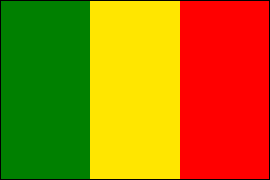
Republic of Mali
• National Flag Since 1961
|
|
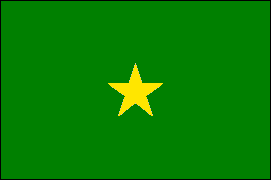
Senegal Pre-Independence Flag • 1946-60 |
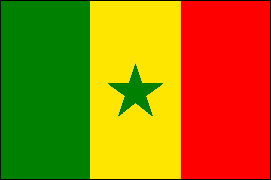
Republic of Senegal
• National Flag Since 1960 |
|
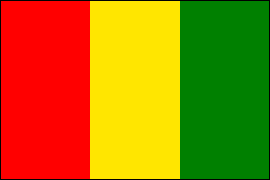
Republic of
Guinea • National Flag Since 1960 |
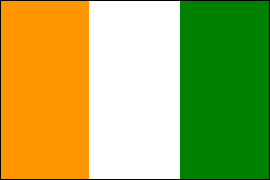
Republic of
Côte d'Ivoire • National Flag Since 1960 |
|
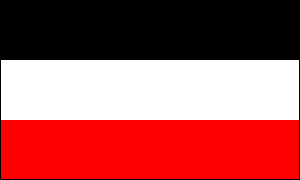
Republic of Upper
Volta • National Flag • 1959-84 |
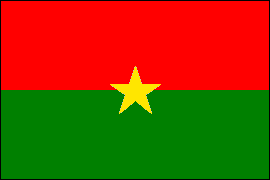
Burkina Faso •
National Flag Since 1984 |
|
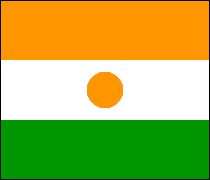
Republic of
Niger • National Flag Since 1960 |
|
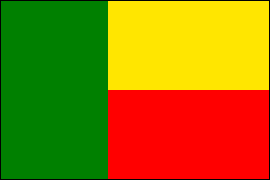
Republic of
Dahomey • National Flag • 1959-75
Republic of
Benin • National Flag Since 1990 |
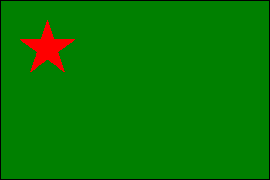
People's Republic of
Benin • National Flag • 1975-90
|
|
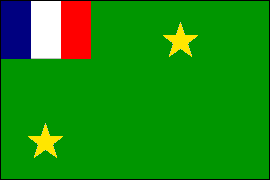
Togo
Autonomous Republic • 1956-60 |
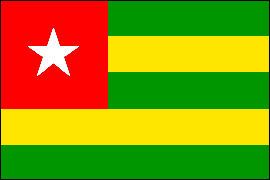
Republic of
Togo • National Flag Since 1960 |
|
FRENCH EQUATORIAL AFRICA
•
Afrique Equatoriale Française |
|
The colonies of French Equatorial Africa received their
independence in 1958-60. Chad adopted a national flag with vertical
stripes of blue, yellow and red—identical to the current national
flag of Romania. At the time, however, Romania was a people's
republic, its flag had the state coat of arms on the yellow stripe,
and so there was no conflict. But in 1989 the People's Republic of
Romania was overthrown and the new, non-communist government made
the plain blue-yellow-red tricolor Romania's national flag. Since
then there have been proposals, mostly in Romania, for design
modifications to distinguish between the two flags. But nothing has
been done so far and since Chad is a remote land-locked country, no
real confusion is caused. The flag of the Central African Republic
combines the Pan-African colors with the colors of France; the
yellow star symbolizes independence. For a brief and farcical period
in the 1970s, the state was known as the Central African Empire but
its flag was not changed. Congo adopted a flag based on the
Pan-African colors and when it made itself a people's republic in
1970 the new flag with its symbols of communism nevertheless
maintained the colors red, yellow and green. When the people's
republic was abolished in 1992 Congo readopted its original national
flag.
Cameroon was a mandate territory
rather than a colony and thanks to this status it was not until 1972
that the current national flag was adopted. The original German
colony (Kamerun) was partitioned between France and Britain, the
latter's portion being a narrow slice adjoining Nigeria. The British
mandate
was eventually
divided into two administrative units, called Northern Cameroon and
Southern Cameroon. As independence drew near, UN-supervised
plebiscites were held in both territories to determine if their
inhabitants wished to join Nigeria or Cameroon. The northern
territory opted for Nigeria and the southern territory chose to
become part of independent Cameroon, which was organized in 1961 as
a federation. The first flag of independent Cameroon had vertical
stripes of green, yellow and red. In 1961 two yellow stars were
placed on the green stripe, symbolizing the federal union of the
French and British mandates. Finally in 1972 a new constitution was
adopted, abolishing the federation and making Cameroon a unitary
republic, called the United Republic of Cameroon. The country's flag
was accordingly modified by replacing the two stars on the green
stripe with one large yellow star on the red stripe. In 1984 the
country was again renamed, becoming simply the Republic of Cameroon,
but this time the flag was not changed.
The colors of the national flag of Gabon represent the land
(green), the equatorial sun (yellow) and the sea (blue). Like Togo,
Gabon had a pre-independence flag with a canton of the French
Tricolor.
|
 Republic of
Chad • National Flag Since 1959 |
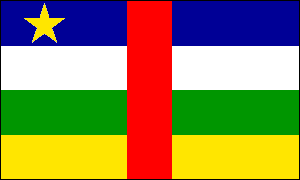
Central African Republic • National Flag Since 1958 |
|
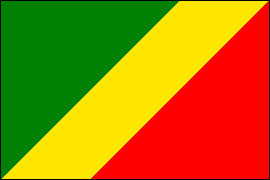
Republic of
Congo
National Flag 1960-70 & Since
1992 |
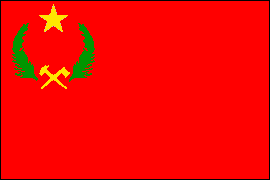
People's Republic of
Congo • National Flag 1970-92
|
|
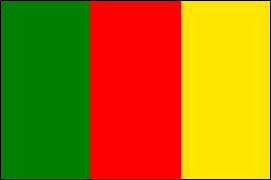
Republic of
Cameroon • National Flag 1960-61 |
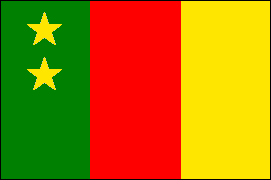
Federal Republic of Cameroon
• National Flag 1961-72 |
|
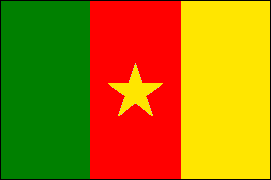
Republic of
Cameroon • National Flag Since 1972 |
|
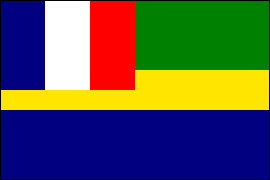
Gabon • Pre-Independence
Flag 1959-60
|
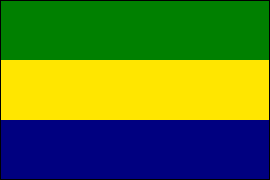
Republic of
Gabon • National Flag Since 1960
|


























